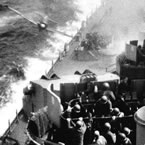wdolson
Posts: 10398
Joined: 6/28/2006
From: Near Portland, OR
Status: offline

|
quote:
ORIGINAL: rtrapasso
It sort of depends on how one looks at it... Japanese held out for years after the war...
It is true that a few die hards held out for years. I believe the last one surrendered in Guam in 1972. There were some Americans who survived on their own too. One on Guam, another gunner from a Helldiver that went down over Japan lived off the land until caught and turned over to the US occupation in 1946. A few scattered Americans lived in the jungles in the Philippines too.
A few of these were groups who were organized into guerilla troops, but most were isolated soldiers who just wanted to survive.
When my father was on Guam, some Japanese came down from the hills and raided the kitchen one night. They didn't want to fight, they just wanted food. My father did take to sleeping with his .45 under his pillow though.
quote:
i look at the failure to Allied eliminate troops in the boondocks as "guerilla" forces which are otherwise not very well modelled in the game... even the few Dutch held out for something like a year in the DEI (despite no outside support and hostile locals). US/PI forces actually grew from almost nothing on Mindanao to something like 30000 troops with minimal outside support.
So when it takes you a couple of months to wipe out some defeated forces, keep this in mind: the game is actually being nicer to you than reality would be.
The few places where guerillas did organize were generally places where the occupying army did not stick around to finish the job of mopping up. Most of the US garrison on Mindanao had the opportunity to dissapear into the hills because they took Davao and left the rest of the island in Allied hands for quite a while, concentrating their forces at Bataan.
If I remember correctly, I dimly recall reading about this a while back, these bands of otherwise lost soldiers on Mindanao were organized into a guerilla force by special agents sent in to raise a guerilla army.
Mindanao was also a very good place to do it. It's been the site of low scale conflict for 500 years. When the Spanish arrived and colonized the Philippines, they found the natives in the north to be open to converting to Catholocism. On Mindanao, Islam had already reached there and the Muslims fought the Spanish instead of converting. Muslim bands of rebels still live in the hills on Mindanao. In the 1940s, this existing army was turned against the Japanese, who the Muslims there considered more evil than the Christians. At least the US had promised to give the Philippines their freedom in 1945 before the war started.
In every case during the war, on all fronts, it was very rare for any organized force to stand up to a strong attacking force for very long after being surrounded. The only cases where the surrounded force did survive more than a few days was when they were also in posession of a fortified base or city with supplies. The 101st's stand at Bastone only lasted because they held the city. If the Germans had been able to drive them from the city, they division would have folded fairly quickly.
McArthur's stand at Corrigedor is another case of a surrounded and battered army holding out in a pre-prepared fortress. His army would never have lasted if he didn't hold what is a base in game terms.
If you push a sizable force out into the countryside without a source of supply, they will cease to have any fighting cohesion after a day or two. In the game, I've seen stacks of 20 divisions hold out for weeks after being pushed out of a base. In one instance, I surrounded a large Japanese force on a non-road, non-city hex just southeast of Rangoon. The force consisted of most of Japan's armor as well as a couple of infantry divisions and some independent brigades. I had snuck a force in behind them to cut off their supply before moving most of my forces in Burma and a good part of the Indian army in to attack them (this was against the AI, so I wasn't worried about being out flanked).
Because of the time it took to move my large force off road to attack them, the Japanese force was out of supply for a couple of weeks before my army got into the same hex. Planting 100,000 troops in the middle of nowhere, then having their supply cut off, they will go through their food fairly quickly. Then a large enemy force assaults them, they will burn through their ammo in fairly short order. Especially after the first week of heavy combat.
Their situation would be far more dire than the British at Arnhem or the Germans at Stalingrad. At Arnhem, the British only had one division, and they were getting some supply from the air. They still didn't last very long. The German sixth army lasted longer, but Germany was putting up the largest airlift of supplies in history to tha tpoint. Every plane that could transport supplies was flying in and out of Stalingrad. The Germans also controlled most of the city for most of the battle.
Any non-Japanese army in the situation of the force near Rangoon would have surrendered. A Japanese army would have died gloriously in banzai charges until they were down to some scattered few who would move into the jungle and cease to be a threat.
I've never seen a banzai charge, but I have heard stories of others who have. I don't know how they are triggered, but the routine that determines when a situation is hopeless does not work very well. Forces and ships will both survive long after the situation would be deemed hopeless in the real world.
I still agree with Japanese_Spirit's feelings about the game overall. Despite the bugs and odd behavior, it is an excellent game with great playability. I expect that I will be playing it, or tinkering with it for a long time.
Bill
|
 Printable Version
Printable Version

 ).
).  )
) 







 and that brought me some bad losses
and that brought me some bad losses 








 New Messages
New Messages No New Messages
No New Messages Hot Topic w/ New Messages
Hot Topic w/ New Messages Hot Topic w/o New Messages
Hot Topic w/o New Messages Locked w/ New Messages
Locked w/ New Messages Locked w/o New Messages
Locked w/o New Messages Post New Thread
Post New Thread